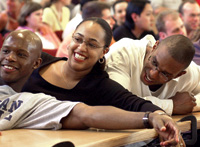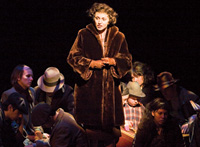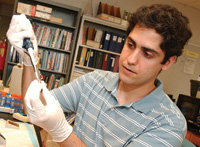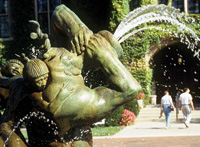Highlights | Campus Initiatives
Diversity Blueprints: U-M Responds to Challenges of Proposal 2

In November 2006, Michigan voters passed Proposal 2, which amends the Michigan constitution to ban public institutions from discriminating against or giving preferential treatment to groups or individuals based on race, gender, color, ethnicity, or national origin. As a result, U-M changed its admissions and financial aid processes so that these factors no longer are used in decision-making.
The following month, U-M President Mary Sue Coleman asked Provost Teresa A. Sullivan and Senior Vice Provost Lester P. Monts to co-chair a University-wide Diversity Blueprints Task Force. Its mission was to identify innovative strategies to sustain and improve effectiveness in recruiting, retaining, and supporting a diverse student body, faculty, and staff, and to enhance the University’s educational outreach and engagement.
After evaluating hundreds of ideas and hours of input, the 55-member Task Force presented its findings in a public meeting on March 28 at Forum Hall in Palmer Commons. The final report recommends seven strategies built around educational outreach and public engagement; admissions, financial aid, and academic support; and campus climate and the University experience.
“The diversity of our faculty, staff, and students is vital to our future academic strength,” Coleman said. “This report presents us with some immediate actions, and a process for moving forward.”

U-M Launches Economic Initiatives
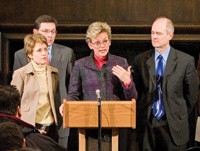 This past year, U-M responded to Michigan’s declining manufacturing sector and soft employment market with multiple initiatives to help bolster the state’s economic recovery.
This past year, U-M responded to Michigan’s declining manufacturing sector and soft employment market with multiple initiatives to help bolster the state’s economic recovery.
- Three projects administered by the U-M Business and Industrial Assistance Division and funded by various state and federal agencies will provide over $5 million to assist Michigan communities facing major plant closures, help manufacturing firms survive in a highly competitive environment, and identify Michigan companies that are creating jobs of the future for which dislocated workers can be trained.
- Soon after Pfizer Inc. announced in January 2007 that it would close its 177-acre Ann Arbor facility by 2008, the University, the State of Michigan, Ann Arbor SPARK, and Ann Arbor area leaders formed the Pfizer Strategic Working Action Teams (SWAT) to aid the more than 2,100 workers who will be displaced.
- In November 2006, U-M, Michigan State, and Wayne State universities created the University Research Corridor, an alliance to transform, strengthen, and diversify Michigan’s economy. The three universities, which annually receive about $1.3 billion in external grants, will reach out to businesses, policymakers, and investors to speed up technology transfer, make resources more accessible, and help attract new jobs to the state.


